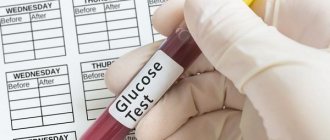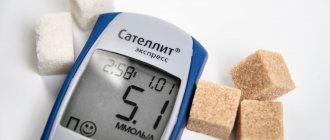13.11.2017
Diabetes mellitus is a group of diseases of the endocrine system that develop due to the lack or absence of insulin (hormone) in the body, resulting in a significant increase in the level of glucose (sugar) in the blood (hyperglycemia).
Diabetes mellitus is mainly a chronic disease. It is characterized by metabolic disorders - fat, carbohydrate, protein, water-salt and mineral. In diabetes mellitus, the functions of the pancreas, which actually produces insulin, are impaired.
Insulin is a protein hormone produced by the pancreas, the main function of which is to participate in metabolic processes - the processing and conversion of sugar into glucose, and the further transport of glucose into cells. In addition, insulin regulates blood sugar levels.
In diabetes, cells do not receive the necessary nutrition. It is difficult for the body to retain water in the cells, and it is excreted through the kidneys. Disruptions occur in the protective functions of tissues, the skin, teeth, kidneys, and nervous system are affected, the level of vision decreases, atherosclerosis and hypertension develop.
In addition to humans, the disease can also affect some animals, such as dogs and cats.
Diabetes mellitus is inherited, but it can also be acquired in other ways.
How does diabetes develop?
The hormone insulin converts sugar into glucose, which is an energy substance necessary for the normal functioning of body cells. When there is a failure in the production of insulin by the pancreas, disturbances in metabolic processes begin. Glucose is not delivered to the cells and settles in the blood. The cells, in turn, starving, begin to malfunction, which externally manifests itself in the form of secondary diseases (diseases of the skin, circulatory system, nervous and other systems). At the same time, there is a significant increase in blood glucose (hyperglycemia). The quality and effect of blood deteriorate. This whole process is called diabetes.
Why is high blood sugar harmful?
High blood sugar levels can cause dysfunction of almost all organs, including death. The higher the blood sugar level, the more obvious the result of its action, which is expressed in:
- obesity;
- glycosylation (sugarification) of cells;
- intoxication of the body with damage to the nervous system;
- damage to blood vessels;
- the development of secondary diseases affecting the brain, heart, liver, lungs, gastrointestinal tract, muscles, skin, eyes;
- manifestations of fainting states, coma;
- lethal outcome.
Symptoms of diabetes
Diabetes mellitus in most cases develops gradually, and only occasionally does the disease develop rapidly, accompanied by an increase in glucose levels to a critical level with various diabetic comas.
The first signs of diabetes
- constant feeling of thirst;
- constant dry mouth;
- increased urine output (increased diuresis);
- increased dryness and severe itching of the skin;
- increased susceptibility to skin diseases, pustules;
- prolonged wound healing;
- a sharp decrease or increase in body weight;
- increased sweating;
- muscle weakness.
Signs of diabetes
- frequent headaches, fainting, loss of consciousness;
- blurred vision;
- heart pain;
- numbness in the legs, pain in the legs;
- decreased skin sensitivity, especially on the feet;
- swelling of the face and legs;
- liver enlargement;
- prolonged wound healing;
- high blood pressure;
- the patient begins to smell of acetone.
Complications of diabetes
Diabetic neuropathy - manifested by pain, burning, numbness of the extremities. It is associated with disruption of metabolic processes in nervous tissue.
Edema. Swelling in diabetes can spread locally - on the face, legs, or throughout the body. Swelling indicates a disturbance in the functioning of the kidneys, and depends on the degree of heart failure. Asymmetrical swelling indicates diabetic microangiopathy.
Leg pain. Pain in the legs with diabetes, especially when walking and other physical activity on the legs, may indicate diabetic microangiopathy. Leg pain during rest, especially at night, indicates diabetic neuropathy. Often, leg pain in diabetes is accompanied by burning and numbness in the feet or some parts of the legs.
Trophic ulcers. Trophic ulcers in diabetes mellitus, after pain in the legs, are the next stage in the development of diabetic angio- and neuropathy. The types of wounds differ greatly from each other, so treatment of trophic ulcers in diabetes is prescribed after an accurate diagnosis, noting the smallest symptomatic details. The negative impact of ulcers is a decrease in the sensitivity of the affected feet, which occurs due to damage to the nerves when the foot is deformed. In some places, this results in corns, under which hematomas are formed with further suppuration. All these processes often occur unnoticeably, so people, as a rule, go to the doctor whose leg is already very swollen, red, and has a trophic ulcer.
Gangrene. Gangrene in diabetes mellitus in most cases is the result of diabetic angiopathy. The onset of gangrene occurs due to damage to small and large blood vessels in the area of the lower limb, most often the big toe. In this case, the patient feels severe pain in the foot. Redness of the damaged area occurs, which over time gives way to bluish skin, and after some time, this area becomes covered with black spots and blisters with cloudy contents. The process is irreversible - amputation of the limb is necessary. The optimal level of limb amputation is the lower leg.
High and low pressure. High and low pressure in diabetes mellitus is observed simultaneously in two points of the body. In the upper part of the body (in the brachial artery) there is increased pressure, which indicates kidney damage (diabetic nephropathy). In the lower part of the body (in the vessels of the legs) there is low pressure, which indicates the degree of diabetic angiopathy of the lower extremities.
Coma. Coma with diabetes occurs extremely quickly. A sign of coma in diabetes is the patient's lethargy and fainting. Before this, a person may smell of acetone coming from the mouth when breathing, which is due to extreme intoxication of the body. In addition, the patient may break into a cold sweat. If the patient exhibits at least one of these signs, he must be taken to a medical facility immediately.
Causes of diabetes
There can be quite a few causes of diabetes, so let’s highlight the most significant:
- heredity;
- age (the older the person, the greater the likelihood of getting sick);
- obesity;
- nervous tension;
- diseases that destroy beta cells of the pancreas that produce insulin: pancreatic cancer, pancreatitis, etc.;
- viral infections: hepatitis, chickenpox, rubella, influenza, etc.
In addition, diabetes mellitus can develop against the background of:
- hyperfunction of the adrenal glands (hypercortisolism);
- tumors of the gastrointestinal tract;
- increased levels of hormones that block insulin;
- liver cirrhosis;
- hyperthyroidism;
- poor digestibility of carbohydrates;
- short-term increase in blood sugar levels.
According to the severity of the disease:
Diabetes mellitus 1 degree (mild form). Characterized by a low level of glycemia (blood sugar) - no more than 8 mmol/l (on an empty stomach). The level of daily glucosuria is no more than 20 g/l. May be accompanied by angioneuropathy. Treatment at the level of diet and taking certain medications.
Diabetes mellitus 2 degrees (moderate form). Characteristic is a relatively small, but already with a more obvious effect, increase in glycemic levels at the level of 7-10 mmol/l. The level of daily glucosuria is no more than 40 g/l. Manifestations of ketosis and ketoacidosis are periodically possible. Severe disturbances in the functioning of organs do not occur, but at the same time, some disturbances and signs in the functioning of the eyes, heart, blood vessels, lower extremities, kidneys and nervous system are possible. Possible signs of diabetic angioneuropathy. Treatment is carried out at the level of diet therapy and oral administration of sugar-lowering drugs. In some cases, your doctor may prescribe insulin injections.
Diabetes mellitus stage 3 (severe form). A typical average glycemic level is 10-14 mmol/l. The level of daily glucosuria is about 40 g/l. There is a high level of proteinuria (protein in the urine). The picture of clinical manifestations of target organs—eyes, heart, blood vessels, legs, kidneys, nervous system—is enhanced. Vision decreases, numbness and pain appear in the legs, and blood pressure increases.
Diabetes mellitus stage 4 (super severe form). A typical high level of glycemia is 15-25 mmol/l or more. The level of daily glucosuria is over 40-50 g/l. Proteinuria increases, the body loses protein. Almost all organs are affected. The patient is prone to frequent diabetic comas. Life is maintained purely on insulin injections - at a dose of 60 OD or more.
Treatment with medications
If you have diabetes, the use of antihypertensive therapy is recommended in cases where blood pressure remains at 140/80 mmHg. even when adjusting your lifestyle through diet, exercise, etc. Target blood pressure is below 130/80 mm Hg. Art. is mandatory if the patient has complications such as damage to the retina, kidney (nephropathy) or brain tissue (stroke).
There are several different medications that can lower blood pressure readings. The choice depends on things like:
- Do you have other health problems?
- Are you taking other medications?
- Possible side effects of the medicine.
- Patient's age and ethnicity.
The first group of drugs that is most often used is a drug called an angiotensin-converting enzyme (ACE) inhibitor. ACE inhibitors protect against kidney damage and also help control blood pressure.
One drug lowers blood pressure to target less than half the time. Therefore, this means that two or more different medications are usually required to achieve the target level (140/80 mmHg or below). In about a third of cases, three or more medications are needed to lower blood pressure to target levels. Therefore, patients with a combination of diabetes mellitus and arterial hypertension need regular consultations with doctors to monitor their health status and adjust treatment.
Diagnosis of diabetes mellitus
The following methods and tests have been established for diagnosing diabetes mellitus:
- measuring blood glucose levels (determination of glycemia);
- measurement of daily fluctuations in glycemic levels (glycemic profile);
- measuring insulin levels in the blood;
- glucose tolerance test;
- blood test for the concentration of glycosylated hemoglobin;
- blood chemistry;
- urine test to determine white blood cell, glucose and protein levels;
- Ultrasound of the abdominal organs;
- Rehberg's test.
In addition, if necessary, carry out:
- study of blood electrolyte composition;
- urine test to determine the presence of acetone;
- fundus examination;
- electrocardiography (ECG).
About the types of blood pressure medications
The leading drugs are diuretics, that is, having a diuretic effect, as well as beta-type blockers, calcium antagonists, otherwise called calcium channel androgens. In addition, this category includes ACE inhibitors and angiotensin II receptors, which can block them.
The combination treatment includes additional types of drugs: rasilez (which is also a direct renin inhibitor), alpha adrenergic blockers, as well as agonists that provide a targeted effect on the nervous system. All these medications should be used only in accordance with medical recommendations. Otherwise, the negative impact can be very significant.
Thus, to lower blood pressure in both types of diabetes, drugs from the following groups are usually used:
- inhibitors: Enalapril, Captopril;
- diuretics: Diacarb, Furosemide;
- beta blockers: “Dilatrend”, “Trandat”, “Nebilet”;
- calcium antagonists: Verapamil, Diltiazem;
- alpha-blockers: Terazosin, Prazosin, Doxazosin;
- stimulants (agonists) of imidazoline receptors: Physiotens, Albarel.
Each group of drugs will be discussed in detail below.
Treatment of diabetes
Before starting treatment, it is necessary to conduct an accurate diagnosis of the body, because a positive prognosis for recovery depends on this.
Treatment of diabetes is aimed at:
- decreased blood sugar levels;
- normalization of metabolism;
- preventing the development of diabetes complications.
Further, treatment varies depending on the type of diabetes. Let's look at them separately.
Treatment of type 1 diabetes (insulin dependent)
As we already mentioned in the middle of the article, in the “Classification of Diabetes Mellitus” section, patients with type 1 diabetes constantly need insulin injections, since the body cannot produce this hormone itself in sufficient quantities. There are currently no other methods of delivering insulin to the body other than injections. Insulin-based tablets will not help with type 1 diabetes.
In addition to insulin injections, treatment for type 1 diabetes includes:
- diet;
- performing dosed individual physical activity (DIPE).
Treatment of type 2 diabetes (non-insulin dependent)
Type 2 diabetes is treated by following a diet and, if necessary, taking antihyperglycemic drugs, which are available in tablet form.
Diet for type 2 diabetes mellitus is the main method of treatment due to the fact that this type of diabetes develops due to improper nutrition of a person. With improper nutrition, all types of metabolism are disrupted, therefore, by changing their diet, a diabetic in many cases gets better.
In some cases, with persistent types of type 2 diabetes, the doctor may prescribe insulin injections.
Diet for diabetes
When treating any type of diabetes, diet therapy is a must.
A nutritionist for diabetes mellitus, after receiving tests, taking into account age, body weight, gender, lifestyle, outlines an individual nutrition program. When dieting, the patient must calculate the amount of calories, proteins, fats, carbohydrates, vitamins and microelements consumed. The menu must be followed strictly as prescribed, which minimizes the risk of developing complications of this disease. Moreover, by following a diet for diabetes, it is possible to defeat this disease without additional medications.
The general emphasis of diet therapy for diabetes is on eating food with minimal or no content of easily digestible carbohydrates, as well as fats, which are easily converted into carbohydrate compounds.
How is blood pressure measured?
Blood pressure is measured using a device called a tonometer. A cuff (thick tape) is placed on the arm.
As air is inflated, the cuff tightens and then slowly relaxes again. During this relaxation, you can listen to the pulsation of the arteries and record the first and last tone to record blood pressure readings. Blood pressure is measured in millimeters of mercury. After the study, the result will be recorded in two numbers: the first is systolic pressure (during ventricular contraction), the second is diastolic pressure when the heart muscle is at rest. According to the principle of operation, tonometers are automatic and manual. When using a manual tonometer, air is pumped using a special bulb, and the first and last tone is heard using a stethoscope.
The automatic blood pressure monitor inflates the cuff and catches the pulse itself. Also, such devices measure heart rate and have a built-in memory for recording readings. It is much more convenient than manual ones, especially for older people.
Combating hypertensive crisis in diabetes
A hypertensive crisis requires an immediate reduction in blood pressure. All of the above medications used for long-term treatment of patients with diabetes are effective, but act slowly. Short-acting medications are used to urgently lower blood pressure.
Pressure figures during a hypertensive crisis will be different for each patient. What medicine should I take before the ambulance arrives and not make my diabetes worse? The most common is the angiotensin-converting enzyme inhibitor captopril. The drug is not contraindicated in diabetes and can quickly reduce blood pressure.
Sometimes it is not enough, then you can supplement the action with the diuretic furosemide. There is an available fixed combination of inhibitor and diuretic - captopres. This drug must be in the first aid kit of a diabetic patient.
A captopril or captopres tablet under the tongue for 10-15 minutes lowers blood pressure. Caution: if the blood pressure numbers are not high, then use half the tablet so as not to cause hypotension.
The fast-acting calcium antagonist nifedipine can also be used. During a hypertensive crisis, the pressure should decrease gradually. During the first hour, blood pressure should be lowered by 25%. Then the decline should be even softer.
Also do the following:
- Lie on the bed with your head elevated and legs down;
- Use a cold compress on your forehead;
- Try to calm down.
As soon as you see high blood pressure numbers, call an ambulance. Qualified specialists will provide further treatment and eliminate complications of the crisis.
How to increase blood pressure with diabetes?
Do not try to increase your blood pressure on your own without consulting a specialist. Get tested to determine the cause of low blood pressure. If you temporarily cannot get to a doctor, try gentle ways to increase your blood pressure:
- Take 1 tablet of ascorbic acid and 2 tablets of green tea extract;
- Measure 30 drops of ginseng root into a glass of water for a single dose;
- A cup of strong green tea.
Essential oils will help increase blood pressure: bergamot, clove, orange, eucalyptus, lemon, spruce. Add a few drops to an aroma lamp or take a bath with 7-10 drops of ether. Do not use other medications without consulting a doctor. They may be contraindicated in diabetes.
If you suddenly feel weak and dizzy, lie down in bed and raise your legs up. The flow of blood from the lower extremities will increase venous return to the heart and increase blood pressure. Acupressure will help normalize the condition: massage your earlobes with gentle movements for several minutes. The reflex point is the area above the upper lip.
Hypotension requires serious medical prescriptions only if it is a manifestation of heart failure. Then the patient is hospitalized and is given lifelong therapy from combinations of several drugs. Discharge is carried out when the condition is restored and the threat to life goes away.
If hypotension is recorded while taking medications that lower blood pressure, the doctor adjusts the dose of the drugs, but does not cancel them. For hypotension against the background of vegetative-vascular dystonia, tonic drugs (Eleutherococcus) and sedatives are used: Adaptol, Afobazol, Glycine and others. Multivitamin preparations may be prescribed in a course.
The following tips will help increase blood pressure in diabetes of any type:
- Normalize your sleep and wakefulness patterns. Sleep at least 7 hours a day and rest after work. Accustom yourself to a certain schedule: get up and go to bed at the same time.
- Spend enough time walking. This is useful both for lowering blood sugar and for increasing body tone. Accustom yourself to morning exercises - physical activity trains blood vessels and is useful for any pathology.
- Drink enough water.
- Do light exercises with your fingers and toes, massage your limbs to eliminate blood stagnation and normalize blood circulation.
- Take a contrast shower every morning.
- Avoid stuffy rooms and sudden temperature changes.
- Eat well, in small portions, but often. This is important both for maintaining normal blood sugar and for normalizing blood pressure.
How to lower blood pressure in diabetes: drug approaches
Drug treatment of arterial hypertension in type 1 and type 2 diabetes is carried out by several groups of drugs. This allows you to potentiate the beneficial effects of different groups, because in addition to lowering blood pressure, they also have other points of application. The requirements for antihypertensive drugs are as follows:
- Maintain normal blood pressure for 12-24 hours;
- Do not affect blood sugar, nor cause hypercholesterolemia;
- Protect internal organs, especially the kidneys, from the harmful effects of arterial hypertension and diabetes.
It is better when 1 tablet includes several antihypertensive drugs. There are fixed pharmaceutical combinations that give a greater hypotensive effect than if the patient takes these medications, only in different tablets: Noliprel, Bi-Prestarium, Equator, Fozid, Korenitek and others.
The following drugs are approved for the treatment of hypertension in diabetes:
- ACE inhibitors (angiotensin-converting enzyme);
- Calcium blockers;
- Some diuretic medications;
- Selective beta blockers;
- Sartans.
ACE inhibitors
The action of drugs for the treatment of hypertension is based on blocking the enzyme angiotensin 2, which constricts blood vessels and increases the production of aldosterone, a hormone that retains water and sodium. This is the first drug prescribed to a patient with diabetes and hypertension for reasons:
- The antihypertensive effect of ACE inhibitors is mild and gradual - a persistent decrease in blood pressure is observed after 2 weeks of taking the drug;
- Medicines protect the heart and kidneys from complications.
The protective effect of drugs in type 1 and type 2 diabetes is due to their effect on the renin-angiotensin-aldosterone system, which prevents early kidney damage. Also, ACE inhibitors prevent the development of atherosclerosis due to the protection of the inner lining of arterioles from the deposition of cholesterol plaques on it. ACE inhibitors have a positive effect on the metabolism of fats and blood sugar, reduce tissue insulin resistance, that is, reduce blood glucose.
Additional effects of hypertension drugs are not observed with all drugs containing inhibitors. Only original medicines protect the heart and affect lipid and carbohydrate metabolism. But generics (copies) do not have such effects. When asked what to buy, cheap enalapril or branded Prestarium, remember this feature.
Disadvantages of medications for the treatment of hypertension:
- ACE inhibitors somewhat slow down the excretion of potassium from the body, so periodic determination of potassium in the blood is necessary. Potassium slows the heart rate and, in excess, can cause life-threatening arrhythmias and cardiac arrest. Hyperkalemia in patients with type 1 and type 2 diabetes is a contraindication for the prescription of ACE inhibitors.
- ACE inhibitors cause a reflex cough in some patients. Unfortunately, this side effect cannot be eliminated and the medicine has to be replaced with sartans.
- High arterial hypertension is not regulated by these drugs, and in some patients the hypotensive effect may not appear at all. In such situations, doctors keep ACE inhibitors as medications to protect the heart and add other antihypertensive medications.
A contraindication for the treatment of hypertension with ACE inhibitors in type 1 and type 2 diabetes (as well as sartans) is bilateral renal artery stenosis. Also, medications are contraindicated in patients who have a history of angioedema (an immediate allergic reaction).
Calcium blockers
Calcium channel blockers or long-acting calcium antagonists reduce blood pressure in patients with type 1 and type 2 diabetes, but have their own contraindications. These drugs are divided into 2 groups: dihydroperidine and non-dihydroperidine. They differ in their mechanism of action.
The main difference is that dihydroperidine blockers increase heart rate, while non-dihydroperidine blockers decrease it. Therefore, dihydroperidines are not prescribed for high heart rates. But for patients with bradycardia, these medications are ideal.
Blockers of both groups are not used for the treatment of hypertension in the acute post-infarction period, in people with unstable angina (a temporary condition that can develop into a heart attack or stabilize) and in case of insufficient cardiac function.
Dihydroperidine blockers reduce the likelihood of developing myocardial infarction in diabetes, but not as pronounced as ACE inhibitors. Antagonists are ideal for treating patients with systolic hypertension and reduce the likelihood of stroke.
Non-dihydroperidine calcium channel blockers are suitable for the treatment of hypertension in patients with diabetic nephropathy. They protect the kidneys from the effects of high blood sugar. Dihydroperidine antagonists do not protect the kidney. All calcium channel blockers for diabetes are combined with ACE inhibitors and diuretics. Non-dihydroperidine blockers should absolutely not be combined with beta-receptor blockers.
Diuretics for patients with diabetes mellitus
To treat hypertension in diabetes, diuretics are always combined with additional drugs, for example, ACE inhibitors. Medicines have different mechanisms of action and are divided into groups. For hypertension, 4 main groups of diuretics are used:
- Loop: furosemide and torasemide;
- Potassium-sparing: veroshpiron;
- Thiazide: hydrochlorothiazide;
- Thiazide-like: indapamide.
Each group has its own characteristics. Thiazide and thiazide-like diuretics have proven themselves to be especially effective in drug combinations for the treatment of hypertension (often with inhibitors). Only the former in large doses can cause an increase in blood sugar, therefore, for hypertension and diabetes of the first and second types, they are prescribed with caution, and in a dose not exceeding 12.5 mg. Considering that the diuretic is combined with another medicine, this amount is sufficient. Thiazide-like diuretics do not affect blood glucose and are well tolerated by patients with hypertension.
Thiazide and thiazide-like diuretics protect blood vessels, preventing or delaying the development of complications from the heart and kidneys. If cardiac function is insufficient, medications are prohibited. These diuretics are not prescribed for the treatment of hypertension due to gout.
Loop diuretics are rarely used for long-term use because they remove potassium through the kidneys. Therefore, when prescribing furosemide and torsemide, potassium supplements must be prescribed. Only these diuretics are allowed for patients with low kidney function, so in cases of severe hypertension, doctors prescribe them for long-term use.
Potassium-sparing diuretics for diabetes fade into the background. They do not harm patients, but have a weak hypotensive effect and are not characterized by any other positive effects. They can be used, but it is better to replace them with other, more useful and effective groups that protect the kidneys and other organs.
Selective beta blockers
Beta-receptor blockers are fairly strong antihypertensive drugs that have a good effect on the heart. They are used in patients with rhythm disturbances and high heart rates. Beta-receptor blockers have been shown to reduce the likelihood of death from heart disease and are among the first-line medications for hypertension and diabetes.
There are 2 main groups of blockers: selective, selectively acting on receptors of the heart and blood vessels, and non-selective, affecting all tissues. The latter are characterized by the fact that they increase tissue insulin resistance, that is, they increase blood sugar. This is an undesirable effect for diabetic patients, so non-selective blockers are strictly contraindicated.
Selective or selective drugs are safe and useful for patients who have diabetes mellitus and hypertension combined with the following pathologies:
- Cardiac ischemia;
- Myocardial infarction (in the early post-infarction period, blockers reduce the likelihood of relapse and restore heart function, and in the late period they prevent the risk of recurrent myocardial infarction);
- Heart failure.
Selective blockers for diabetes combine well with diuretics. Less commonly used together with ACE inhibitors and calcium blockers.
Beta receptor blockers (selective and non-selective) are contraindicated for the treatment of hypertension in patients with bronchial asthma, as they can worsen the course of the disease.
Sartans
The mechanism of action of drugs is similar to ACE inhibitors. Sartans are rarely used in the complex of first-line drugs; they are prescribed when taking ACE inhibitors in a patient provokes a cough. These medications protect the kidneys, lower cholesterol and blood glucose, but to a lesser extent than ACE inhibitors. Sartans have a higher cost, and fewer fixed combinations with other antihypertensive drugs are known.
Sartans are one step above ACE inhibitors when it comes to treating patients with an enlarged left stomach. It has been proven that these drugs not only slow down hypertrophy, but also cause its reverse regression.
Like ACE inhibitors, sartans cause potassium accumulation, so hyperkalemia in type 1 and type 2 diabetes is a contraindication to the use of drugs. The drugs combine well with diuretics and will be effective as monotherapy. In combination with sartans, the effectiveness of calcium blockers improves (as when taking ACE inhibitors).
Additional groups of antihypertensive drugs - alpha blockers for diabetes
When taking the main medications to treat hypertension is not possible, or a combination of the two medications described above does not give the necessary antihypertensive effect, drugs from the reserve groups are added to treatment. There are quite a lot of them, so we will consider only alpha-receptor blockers that are approved for type 1 and type 2 diabetes.
The advantage of these drugs is that they reduce prostatic hyperplasia, so they can be used as the drugs of choice for treating patients with this problem and diabetes. At the same time, medications increase the risk of developing heart failure. This effect has not been definitively proven, but alpha-receptor blockers are not used in patients with existing heart failure.
Among other positive effects, we note their effect on blood glucose. Medicines increase tissue sensitivity to insulin and reduce blood sugar, which is necessary for diabetes.
What medications for arterial hypertension are contraindicated in diabetes?
Due to the high prevalence of hypertension, doctors have many groups of drugs that lower blood pressure in their arsenal. Some of them cause an increase in blood sugar and are strictly contraindicated for patients with diabetes. This is especially true for non-selective beta receptor blockers.
They are absolutely contraindicated in cases of impaired glucose tolerance (prediabetes). Also, medications are prescribed with caution to patients whose blood relatives have diabetes.
In diabetes, thiazide diuretics in doses greater than 12.5 mg are contraindicated. Their effect on insulin and blood glucose is not as pronounced as that of non-selective beta-receptor blockers and non-dihydroperidine calcium antagonists, but it is still present.
How to eliminate arterial hypertension: general recommendations
If you have hypertension, you should reduce your salt intake, as it causes fluid retention and arterial hypertension. Patients with diabetes are more sensitive to sodium, so it is strongly recommended to reduce the amount of salt.
You should also limit your fluid intake to 1 liter per day (in hot weather you are allowed to drink about 1.5 liters). Liquid is not only water, but also juices, soups, vegetables, fruits.
Food should be salted less, gradually the taste buds will adapt, and it will not seem bland. A simple rule from European experts: “Take the salt shaker off the table” will help you start consuming less salt. This simple measure will eliminate the habit of adding salt to food and reduce salt consumption by about a quarter.
The following recommendations will help improve the quality of life with diabetes and hypertension and reduce the dose of antihypertensive drugs:
- Give up alcohol and cigarettes;
- Get enough sleep - sleeping at least 7 hours a day is the key to a good emotional state and equal blood pressure;
- Walking in the fresh air calms the nervous system and improves heart function;
- A low-carbohydrate diet, avoiding fatty and fried foods will reduce the negative impact on blood vessels, minimize the likelihood of developing atherosclerosis, and reduce the severity of hypertension;
- Excess weight always accompanies high blood pressure, so losing weight slowly will help reduce the symptoms of hypertension and improve the general condition of the body.
Antihypertensive drugs have a cumulative effect, so they should be taken regularly. Normalization of blood pressure means that the treatment is effective. Don't think that you have cured your hypertension and can quit the pills. This disease is incurable and requires lifelong treatment. And intermittent therapy will only worsen its course.










